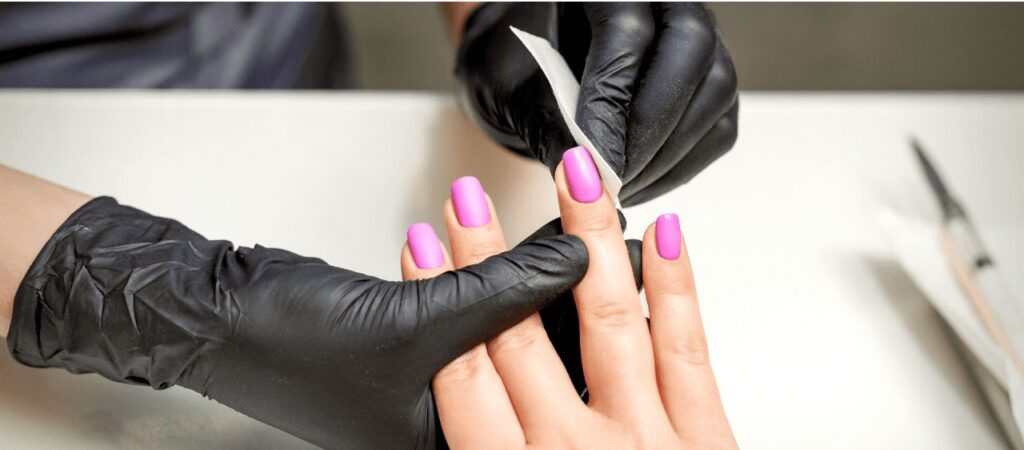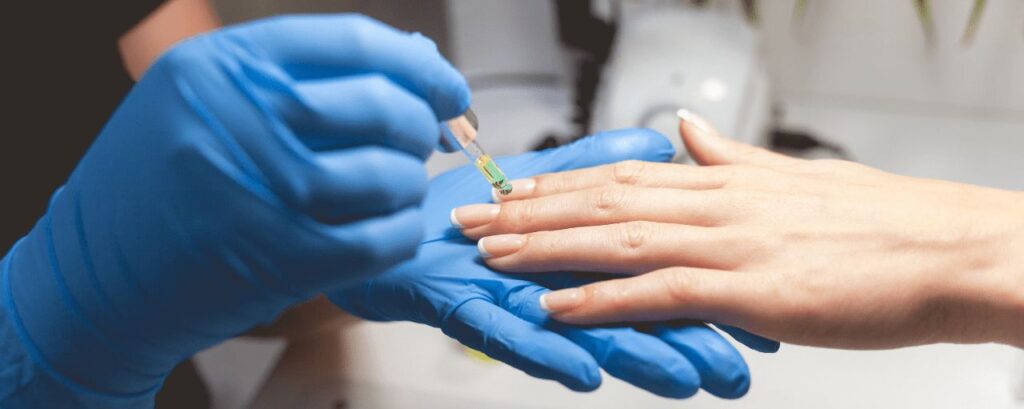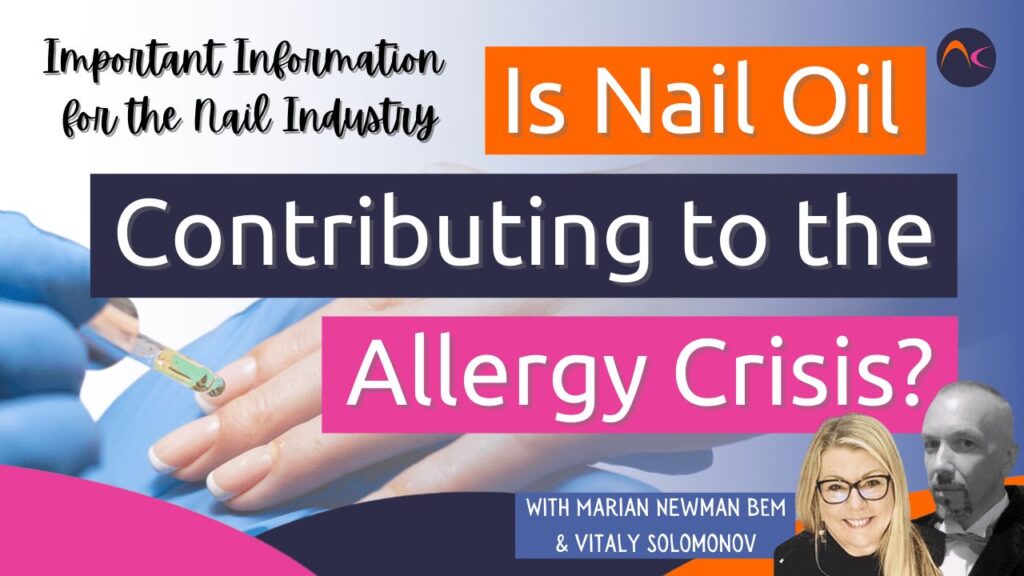We know about allergies. We know about sub-standard nail products. But this is very important information for the Nail Industry.
Acaba de publicarse una investigación muy reciente (agosto de 2021 en The Journal of Allergy and Clinical Immunology) que ha puesto de manifiesto otra cuestión de la que DEBEMOS ser conscientes y a la que debemos prestar atención. Hay mucha información sobre skin moisturisers in beauty products, but this article is just concerned with how us, as nail professionals, are affected.
Mi amigo y colega, Vitaly Solomonov, dermatologist and expert for NailKnowledge has also provided some more science and the references to support this information – Azul resaltado.
Se han publicado tres estudios y hay más en curso.
What has been shown is that many ‘natural oils’ are harmful to the skin and disrupt the skin barrier.
The most relevant cause for concern in nail services is regarding UV gel top coats. Both traditional and ‘tack-free’.

EVERY nail professional, surely, must know that the sticky layer remaining after curing is unreacted product? But how many take the time and have the understanding that this must NOT touch the skin during the final cleansing?
Existen 2 métodos para hacerlo de forma segura:
- Soak a pad in the recommended cleanser (which is usually an alcohol such as IPA). Start at the little finger and wipe the nail from base to free edge and NOT backwards nor side to side. Move onto the larger nails so the product on the pad is not touching the skin.
- Aún más seguro es utilizar una almohadilla empapada nueva para cada uña.
¿Cuántas veces has visto esa almohadilla frotada por toda la uña y por lo tanto la piel y la misma área de almohadilla utilizada para cada uña? ¡Esto es depositar producto no curado en toda la piel circundante!
Esmaltes de acabado sin adherencia: puede que no resulten pegajosos y algunos los utilizan para ahorrar tiempo al no tener que realizar el paso final de limpieza. PERO todavía tienen algo de producto sin curar en la superficie. DEBEN limpiarse.
¿Cuál es el paso más común después de esto? El aceite. Masajearlo alrededor de la uña y la piel.

Entonces, ¡aquí está el problema! Producto sin curar está en la piel, se aplica aceite.
What the studies have shown is that the oil can act as ‘penetration enhancers’. This means that they are encouraging the penetration of allergens (placed onto the skin during the service) directly into the living cells of the skin!
De Vitaly:
En primer lugar, permítanme resumir los resultados de los estudios recientes que Marian ha mencionado anteriormente. Esos trabajos han aportado noticias verdaderamente revolucionarias y pueden tener repercusiones para varias industrias, incluida la de las uñas, desde varios puntos de vista. He aquí la conclusión más importante, entre otras, que podemos extraer de los estudios:
It has been shown that the moisturisers (lotions and oils) that are widely used in baby skin care led to development of food allergy, atopic dermatitis and even asthma in the future life of an infant if they used frequently.
This sounds too scary, doesn’t it? However, let’s get started to sort things out to understand what is going on.
The phenomenon that mentioned in the first notion occurs because oils, especially those natural oils like olive, sunflower and many others may partly disrupt the skin barriers and potentiate the permeation of many compounds including allergens. The oils or lipid compounds can dissolve the allergenic substances and make them available to the immune cells in our skin. For instance, the trace neglectable amounts of milk shakes or mixtures for infants can be left on a baby’s skin after the contact with parents’ hands. Then, when we apply the moisturiser, its lipid components encourage the penetration of them into the baby’s skin. If the immune cells recognize the food components to be allergic, the reaction begins, and allergy develops immediately or many years after when a kid becomes an adult. That is why, one of the authors openly declare the following motto: “Olive oil is for food, not for skin care”, despite the current fashion for so called ‘natural’ or ‘organic’ products.
The data can be logically applied for our salon services because a nail technician often deal with potentially allergic substances such as uncured gels or ‘tacky residue’. Thus, the tacky residue being mixed with the oily components of the cosmetic products and easily penetrate the skin. It is important to note, that the components of nail products are not allergens itself. True allergens are always proteins. The components of UV gels, nail polishes or acrylics are not proteins. Now you can ask – Why are they considered to be potential allergens then? The key word here is ‘potential’. These substances that can be potentially harmful for your skin have their own name – let me introduce them – haptens. Haptens are substances of different chemical classes. They usually have a small molecular mass and can penetrate the skin barriers. They are not considered as allergens unless they come into reaction with our own proteins that are found in our skin. In this case they form the compound that become an allergen for us. Most of haptens are ‘oil loving’ molecules, which means that they can be dissolved in oils, which in turn helps them to penetrate the skin where they meet the lipid bilayers of our own Stratum Corneum and mix with them too.
Good news is that our skin is not a static structure or just a container that contains some mixtures. It has its structure, and the structure defines the health of our skin. The skin’s major responsibility is to protect us, and it means that all the skin structures do their best to prevent the permeation of almost all the outer substances, even those that are considered as ‘good for us’. Moreover, the human’s skin is ever changing organ and it strives to free our body from harmful or unnecessary substances by pushing out old layers and cells. The latter are just removed from the surface of the skin. It helps to ‘clean up’ the space.
On the other hand, we have to learn that cosmetic products may have an impact on very important structures in the stratum corneum. The most important part of those structures is lipids/water ratio (and water retaining substances, which are known as the natural moisturising factor). These two components create the optimal consistency of our skin, where the essential lipids are a key factor since they create the compact barrier. When it becomes too thick the skin is getting scaly and dry. When those lipids become too liquid, the skin becomes too prone to inflammation due to the partially disrupted barriers.
¿Qué es importante para nosotros y nuestro trabajo?
1) The frequent use of moisturisers can be harmful. Then the next question – what is ‘frequent’ use? The answer to the question – use your moisturiser 1-2 times a day. If you have symptoms of xerotic skin, use the special lotions and as professionals don’t blindly follow the marketing claims. Read the list of ingredients.
2) Oils. It is obvious, that we use the cuticle oils to prevent water evaporation from the area that we worked on, because some procedures (especially those that are well known as harmful – abrasions, solvents, peelings, etc. lead to water loss and dryness). Dryness is a first signal of disrupted skin barriers and the first step of possible skin inflammation). Always use the cuticle oils after you wash your hands with a soap or liquid soap.
3) Una vez finalizado el servicio y creado el siguiente conjunto perfecto de uñas bonitas, pida a su clienta que se lave las manos con jabón antes de aplicar una loción, crema o cualquier otro producto hidratante para evitar posibles brotes de alergia.
4) If you work with a ‘tacky layer’, thoroughly remove it out first with acetone or isopropyl alcohol and then always wash with a soap before your next step in service.
5) Never touch skin with a product and keep your brush and other utensils clean even if you work in gloves.
6) Si notas que tu crema hidratante habitual te provoca cierta sequedad, cámbiala por otra con una fórmula e ingredientes más avanzados.
7) Avoid products with a huge load of essential oils, fragrances, and colorants – it will help to avoid allergy outbreak.
8) Avoid products that are advertised as ‘natural’ – that doesn’t mean they are safer. Often, most of them are considered as more allergenic, especially for the vulnerable skin types. Studies confirm this notion.
Otra causa más de brotes de alergia en nuestro sector.
Oil is a ‘non-negotiable’ addition to every nail servicio y atención domiciliaria por lo que este paso no se puede evitar. ¡Pero añadir un problema a una alergia potencial es 100% evitable!
Conozca sus productos y la ciencia. Trabaje con seguridad y minimice los daños que pueda causar a sus clientes y a usted mismo.


